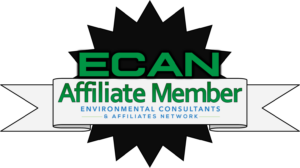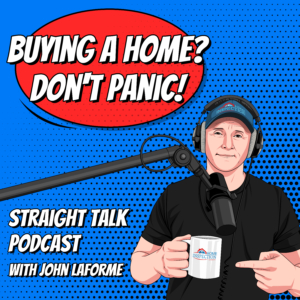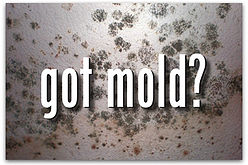The Purpose of a visual Moisture and Mold inspection is to identify the presence of mold growth or elevated moisture levels or moisture damage to your home or office. We use specialized equipment and training to detect if moisture is present such as thermal imaging gun and moisture meter technology. The inspectors findings will be delivered to you in a comprehensive digital report with photos. We also highly recommend Indoor air quality testing for elevated mold spores along with our Moisture and Mold inspection service, This service is also commonly performed by itself for customers during our general home inspection service who have sensitivity to air quality at an additional fee.
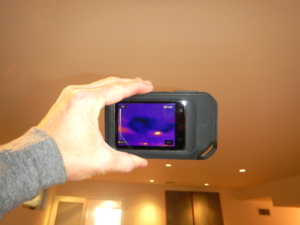
Photo above shows 3′ wide anomaly observed with a Thermal Imaging Gun not visible to the naked eye. The ceiling had no visible indicators of a moisture issue. This was confirmed as moisture with moisture meter.
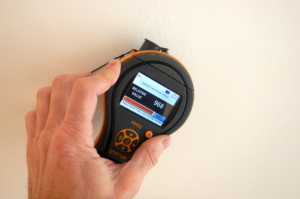
Have you checked your water pressure regulator lately?
We have discovered several times during our Mold inspections that water pressure regulators have failed. This means the water pressure is too high which puts too much stress on the water supply piping, faucets and fixtures, water heaters etc. This condition may eventually lead to slow leaks in walls or ceilings which may go undetected for months, and or pipe bursts in the building which will cause major flooding and water damage. We have seen major damage occur from the failed water pressure regulator causing thousands of dollars in repairs and weeks of inconvenience to occupants during the remediation process. We strongly recommend testing your water regulator once a year and make sure it is no higher than 75 PSI.
Whether you are buying, selling or renting a property or just want to ensure your present home or business has no visible mold present or poor indoor air quality, we can provide the professional service you need for piece of mind before moving into your new home or business. Our certified mold professional will perform a visual survey of your home or building. Using a variety of mold testing methodologies and 3rd party forensic lab analysis on air or surface samples collected. we can provide you with a detailed lab report of the findings and our recommendations for further remediation if mold is detected.

Photo Above shows Black Mold (Stachybotrys) in plain-sight under a kitchen sink.
How Will You Know If You Need A Mold Inspection?
Do you see black or brown stains on walls or ceilings in your home or business?
Do you smell a musty odor in a specific room in your home or business?
Are you experiencing roof leaks or plumbing leaks in your home or business?
If yes to any of the above then you may have a moisture intrusion problem and a possible mold problem.
We only provide Moisture and Mold inspections and testing, we do Not offer mold remediation services so we can offer you a honest non bias opinion of current conditions that may be conducive for mold to grow in your home or business.

Determining if mold exists in your home or business is a process:
The 1st step: Is to have our Certified mold inspector perform a non bias visual inspection along with air and surface samples if needed. Our certified mold inspector will visually inspect your home or business for visible mold and elevated moisture levels as well as conditions that may be conducive for mold to grow in the future.
The 2nd Step: If mold is observed during the visual inspection or if air and surface sampling test positive from the 3rd party laboratory, then a more intrusive inspection ( Mold Remediation ) may be needed by a qualified licensed professional. This intrusive inspection may require removal of drywall or plaster, cabinets or roofing materials to determine the amount of affected areas and find source of moisture. Then repair the source of moisture and remove all damaged materials, then dry out the affected areas with specialty mold remediation equipment such as Air Movers, Air Scrubbers and or Dehumidifiers.
The 3rd Step: Once the mold affected areas have been removed and source of moisture has been repaired and the mold affected areas have been dried completely a clearance test should be performed by us a non bias testing company. A minimum of 2 air samples should be taken in the mold affected containment area before any building materials are reinstalled. Once the test results are negative the contractor can rebuild the affected area of your home or building and then you can once again enjoy your home or business.
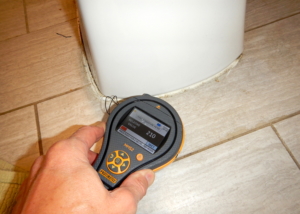
What to Expect during the The Mold Inspection?
We will visually survey the structure’s interior for moisture stains/damage or possible moisture intrusion areas, as well as collect relative humidity, temperature and moisture reading measurements using moisture meter and thermal imaging technology. Should your property contain evidence of indoor mold growth, or conditions consistent with mold growth, we will recommend a sampling protocol, the sampling protocol is based on the overall condition of your property at the time of inspection. The mold inspector will explain how many samples are recommended however you will have final decision of how many we take aside from minimum of 2 air samples needed.
Surface And Air Sampling Information
Surface sample collection identifies what types of mold are found on a surface. Air sample collection identifies what types of mold spores are in the air and quantifies the amounts of each type. Air sample collection requires a minimum of two samples collected in order for the third party laboratory to have an outdoor control sample for comparative analysis. The indoor mold spore levels in your home should be similar to or lower than those in the outdoor environment.

What does mold need to grow?
Mold requires moisture as well as a substrate or surface to grow on. High humidity, typically more than 60% may also provide an ample source of moisture for mold growth. Substrates such as wood, wallboard, ceiling tiles, carpet, wallpaper, paneling and leather items are favorite breeding grounds.
(Mold inspection is outside the scope of a general home inspection and NOT included, It is offered as an additional service for a fee).
